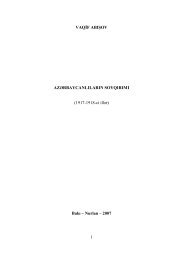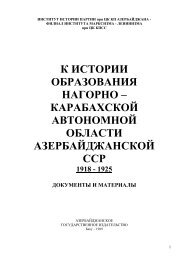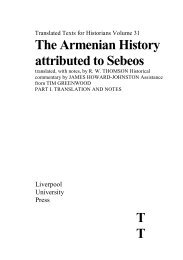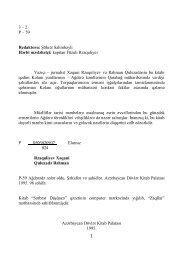ARMENIAN - Erevangala500
ARMENIAN - Erevangala500
ARMENIAN - Erevangala500
Create successful ePaper yourself
Turn your PDF publications into a flip-book with our unique Google optimized e-Paper software.
The Armenian residential and administrative areas centred<br />
on Kum Kapi on the shore o f the Sea o f Marmara,<br />
where even today the Gregorian Patriarchate is to be<br />
found. The wealthy Armenians lived, as did the Greeks,<br />
mainly in the new quarter known as Pera. The historic<br />
city o f Constantinople was thus situated between the teeth<br />
o f a pair o f pincers consisting o f dissident inhabitants<br />
who in April 1915 were waiting for their hour to come.<br />
In the early months o f 1915 the Ottoman authorities were<br />
confronted with the problem that Constantinople was<br />
threatened on two sides, by the French and British fleets<br />
lying in wait before the Dardanelles on one hand, and<br />
from the Eastern front on the other. After the collapse o f<br />
the winter offensive under Enver Pasha and the annihilation<br />
o f the 3rd Army, which had under his command<br />
failed to advance towards Russia over the Caucasus,<br />
Eastern Anatolia was left almost entirely without any<br />
means o f defending itself against Russian attack. Only a<br />
few regiments o f the 95,000-strong 3rd Army had survived;<br />
almost 75,000 men had been lost. It was clear to all<br />
concerned that the losses had been incurred not only<br />
because the troops had been poorly armed and equipped<br />
but also because they were massively betrayed by the<br />
Armenian inhabitants o f the region, who put their hopes -<br />
vainly, as it turned out - in the Russians. The letter o f<br />
thanks which Enver sent on ahead in February to the<br />
Gregorian Bishop o f Konya only proves that the commander<br />
clearly recognized the importance o f the<br />
Armenian forces.<br />
In March 1 9 1 5 a carefully prepared uprising broke out in<br />
Zeitun which was intended to break open the sparingly<br />
manned Ottoman front from behind. The motivation<br />
behind this attack was the Armenians' strategically well-<br />
conceived plan to conquer the zone around Alexandrette<br />
(Iskenderun) in south-eastern Anatolia, where the<br />
Ottomans only had a limited troop presence, and thus to<br />
cut the Empire into two parts. A few months later, in July<br />
1915, this offensive was indeed carried out with French<br />
support on Musa Dag, but failed as a result o f the resistance<br />
o f the defending forces.<br />
The picture is rounded out by uprisings in Van, which fell into<br />
the hands o f the Armenian franc-tireurs in 1915, and in Mu§,<br />
Sassun, Erzindjan, Erzurum, Kharput, Sivas, Diyarbekir,<br />
Ankara, and Trapezunt, not to mention also within the bound<br />
aries o f Istanbul itself (Bursa, Yalova, Adapazar ...).<br />
80<br />
The goal o f the Armenians - who were undeterred by the<br />
fact that they were nowhere in the majority - was the<br />
establishment o f an independent State. And the Russian<br />
authorities in St. Petersburg - neither Tsar Nicholas nor<br />
the "red Tsars" who followed him ever dreamt o f granting<br />
the Armenians independence - were attracted by the<br />
imminent possibility o f an attack on Constantinople and a<br />
breakthrough to the "warm seas".<br />
All this was to be made possible by the Armenian uprisings<br />
in the east and south-east o f the Empire, and the<br />
advance o f the united French and British forces over the<br />
Dardanelles to Constantinople-Istanbul, the latter to be<br />
assisted in a special way by Annenian bands in and<br />
around the capital. The model was to have been Van.<br />
The advance of the British-French fleet before the<br />
Dardanelles, and their attem pt to break through to<br />
Constantinople in conjunction with the same kind of<br />
Armenian uprising in the capital as had been carried<br />
out successfully in Van.<br />
The Gallipoli campaign took actually place between April<br />
and Decem ber 1915 in an effort to conquer the<br />
Dardanelles from the Turkish Ottoman Empire and thus<br />
force it out o f the war. Some 60,000 Australians and<br />
18,000 New Zealanders were part o f a larger Bitish force.<br />
At the end some 26,000 Australians and 7,500 New

















